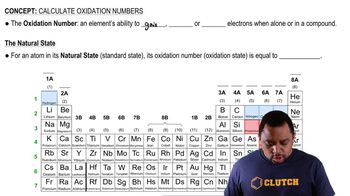Here are the essential concepts you must grasp in order to answer the question correctly.
Oxidation Numbers
Oxidation numbers are a way to keep track of electrons in chemical compounds. They indicate the degree of oxidation of an atom in a molecule, helping to determine how electrons are transferred during reactions. The oxidation number is assigned based on a set of rules, such as the fact that the oxidation number of an element in its elemental form is zero, and the sum of oxidation numbers in a neutral compound must equal zero.
Recommended video:
Rules for Assigning Oxidation Numbers
There are specific rules for assigning oxidation numbers, which include: oxygen typically has an oxidation number of -2, hydrogen is usually +1, and alkali metals are +1 while alkaline earth metals are +2. In compounds, the more electronegative element is assigned a negative oxidation number, while the less electronegative element is assigned a positive one. These rules help in systematically determining the oxidation states of all elements in a compound.
Recommended video:
Mn2O7 Structure and Oxidation States
In the compound Mn2O7, manganese (Mn) and oxygen (O) are the key elements. Given that oxygen has an oxidation number of -2, the total contribution from the seven oxygen atoms is -14. To balance this in a neutral compound, the total oxidation number for the two manganese atoms must be +14, leading to each manganese having an oxidation number of +7. This illustrates how to apply oxidation number rules to a specific compound.
Recommended video:
 Verified step by step guidance
Verified step by step guidance


